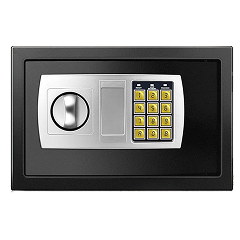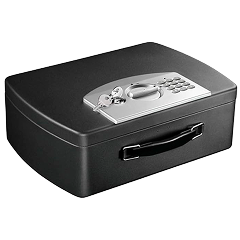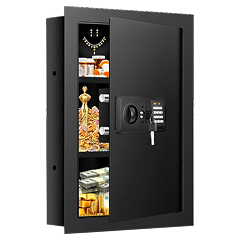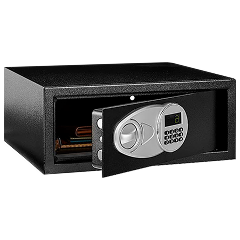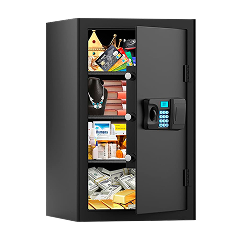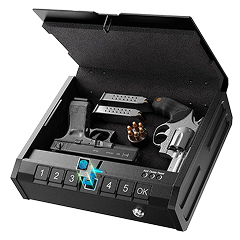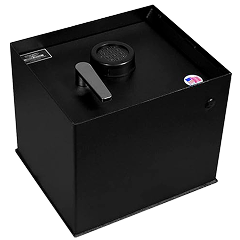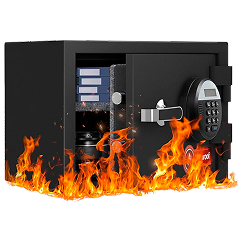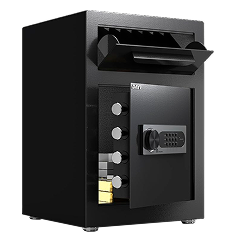Las cajas fuertes de suelo solucionan una de las desventajas de los modelos tradicionales: se ocultan al completo. Después de tener dos cajas fuertes convencionales durante años (una caja fuerte de combinación pesada de 36 kg y una caja fuerte portátil ignífuga de llave) aprendí que las cajas fuertes visibles llaman mucho la atención.
Si bien mi caja fuerte pesada es difícil de robar, lo cierto es que su presencia es más que evidente para cualquiera que entre en la habitación donde se encuentra. Por su parte, las cajas fuertes de suelo no te dan este problema, ya que se ocultan bajo el suelo y su existencia es invisible para los ladrones que no saben exactamente dónde buscar.
Como ingeniero y propietario con amplia experiencia investigando tecnologías de seguridad, he observado que las cajas fuertes de suelo presentan ventajas significativas respecto a las instaladas en la superficie, especialmente por su versatilidad a la hora de instalarlas y su capacidad disuasoria ante robos.
Esta guía ofrece un análisis detallado de las especificaciones técnicas y los aspectos prácticos exclusivos de las cajas fuertes de suelo, como los requerimientos estructurales del hormigón o la forma de lidiar con la humedad, temas que rara vez se tratan en las recomendaciones generales de compra.
Si bien mi guía principal del comprador cubre principios universales, como mecanismos de bloqueo y clasificaciones ignífugas, esta guía aborda los desafíos y beneficios específicos de colocar una caja fuerte de suelo.
Elige la clasificación de seguridad adecuada a tus necesidades
La clasificación de seguridad de las cajas fuertes de suelo sigue los mismos estándares básicos que los de las cajas fuertes tradicionales, pero el método de montaje determina la efectividad de la clasificación en el mundo real.
Clasificación RSC: la opción estándar
La clasificación RSC (Residential Security Container) es el estándar mínimo de la mayoría de las cajas fuertes de suelo y proporciona una protección adecuada para las pertenencias valiosas de cualquier hogar. Las conclusiones de mi investigación apuntan a que los modelos con clasificación RSC deben resistir un ataque de cinco minutos con herramientas manuales básicas, palancas y herramientas eléctricas pequeñas.
Al estar construidas en el suelo, estas cajas fuertes son más difíciles de atacar con herramientas de apalancamiento, lo cual dota a los modelos RSC de una seguridad más práctica que la de las cajas fuertes normales.
Clasificación B y superior: para cuando necesites algo mejor
Las cajas fuertes de suelo de clasificación B están construidas con un acero más grueso y tienen una mayor protección contra métodos de ataque más sofisticados, aunque cuestan mucho más que los modelos RSC. Lo normal es que estos modelos resistan ataques durante 15-30 minutos con herramientas más potentes.
En las versiones de suelo, la verdadera ventaja proviene del mayor grosor del acero, más que del tiempo de resistencia ante ataques, ya que el hormigón que las rodea limita la forma en que los atacantes pueden posicionar sus herramientas.
Nivel de seguridad en el día a día
La mayor ventaja de seguridad de cualquier caja fuerte de suelo no reside en su calificación, sino en su ocultación y montaje. Incluso una caja fuerte de suelo básica RSC se vuelve algo extremadamente difícil de abrir cuando los atacantes no pueden aplicar el apalancamiento y el posicionamiento que funcionarían con las cajas fuertes normales. Los cimientos de hormigón de tu hogar se convierten en parte del sistema de seguridad de la caja fuerte, algo que ningún sistema de calificación refleja al completo.
Protección ignífuga en las cajas fuertes de suelo
La protección ignífuga de las cajas fuertes de suelo funciona de manera distinta a la de las normales, debido a su ubicación y limitaciones de instalación.
Clasificaciones ignífugas
La mayoría de las cajas fuertes de suelo tienen clasificación ignífuga de 30, 60 o 90 minutos. Esto sirve para indicar el tiempo que su interior estará lo suficientemente frío como para proteger tus pertenencias cuando la temperatura no supera los 176° C durante su exposición al fuego. Lo interesante de la colocación subterránea de estas cajas fuertes es que el hormigón circundante actúa como un disipador de calor gigante, lo cual aumenta la protección ante el fuego más que si se encontrara en la superficie.
Umbrales de temperatura y protección de documentos
Lo de que la temperatura no sobrepase los 176° C no es algo aleatorio, se toma como referencia porque el papel comienza a descomponerse a los 204° C, así habrá un pequeño margen si las cosas salen mal. Mi caja fuerte con cerradura de llave y resistente al fuego usa este mismo estándar y sé lo bien que funciona para proteger documentos importantes. Las cajas fuertes de suelo se benefician de la estabilidad de la temperatura del suelo, pero también se enfrentan a los riesgos de la humedad, ya que puede dañar los documentos incluso cuando la protección ignífuga funcione a la perfección.
Razones para elegir lo sencillo en lugar de lo resistente al fuego
Después de evaluar las diferentes opciones, me decidí por cajas de seguridad básicas, en lugar de por modelos de suelo resistentes al fuego para satisfacer mis necesidades específicas. Las cajas fuertes de suelo resistentes al fuego son más costosas, ocupan mucho más espacio y siguen sin igualar la protección de documentos que ofrecen las cajas fuertes resistentes al fuego específicas, como la del modelo portátil que tengo.
El simple hecho de estar ubicada bajo suelo proporciona una protección natural contra incendios y permite proteger artículos de alto valor que no sean de papel. Por esta razón, la clasificación ignífuga pierde importancia en comparación con la seguridad y la protección contra la humedad.
Tipos de cerradura en las cajas fuertes de suelo
La tarea de elegir cerradura se vuelve más compleja en las cajas fuertes de suelo, ya que no puedes acceder fácilmente al mecanismo de mantenimiento o cuando simplemente quieres cambiar la batería. A partir de mi experiencia con las cerraduras de combinación y con las de llave, así como después de investigar sobre las opciones electrónicas, así es como funcionan los modelos de suelo:
- Cerraduras de dial tradicionales: estos sistemas mecánicos son los más fiables para las cajas fuertes de suelo, ya que no necesitan baterías y rara vez requieren mantenimiento. De hecho, son similares a mi caja fuerte pesada de combinación que ha funcionado perfectamente durante años.
- Cerraduras con llave: si bien son sencillas, tienen el riesgo adicional de que puedes perder las llaves cuando más necesites acceder a tu caja fuerte.
- Cerraduras digitales: los teclados electrónicos brindan comodidad y múltiples códigos de usuario, pero reemplazar la batería se convierte en un verdadero dolor de cabeza cuando la caja fuerte está bajo suelo.
- Sistemas de doble bloqueo: la combinación de dos tipos de bloqueo diferentes te brinda opciones de respaldo si uno falla, aunque esto añade ciertos costes y convierte a la instalación ya de por sí desafiante en algo más complicado.
Requisitos de construcción e instalación
Las cajas fuertes de suelo se diferencian de los modelos tradicionales en que el cuerpo de la caja debe soportar la presión del hormigón y la exposición a la humedad a la vez que mantiene su integridad estructural. El grosor del acero es un factor mucho más importante en las cajas fuertes de suelo que en las cajas fuertes normales, ya que no puedes mover una caja fuerte de suelo si hay algún problema.
Son muchos los propietarios que se centran únicamente en el grosor de la puerta sin prestar atención a la estructura de la caja, que con el tiempo se convierte en un punto débil cuando el hormigón se asienta a su alrededor.
El proceso de instalación requiere más precisión que el de cualquier otro tipo de caja fuerte y los errores se pagan en seguridad y dinero. Mis cajas fuertes portátiles las pude instalar por mi cuenta, pero las cajas fuertes de suelo necesitan un montaje profesional para cumplir con las especificaciones del fabricante y mantener la cobertura de la garantía. Además, la instalación con el hormigón implica múltiples pasos que afectan tanto a la seguridad como a la longevidad de la caja fuerte.
Requisitos básicos que afectan al funcionamiento a largo plazo:
- Espesor mínimo del hormigón de 10 centímetros: una cobertura adecuada evita la infiltración de humedad y mantiene el soporte estructural alrededor del cuerpo de la caja fuerte.
- Preparación de una base nivelada: con el tiempo, una base desigual puede causar problemas de alineación de puertas y tensión en el mecanismo de bloqueo.
- Factores a tener en cuenta en el sistema de drenaje: la mala gestión del agua conduce a la oxidación de los materiales y a fallos en las cerraduras, incluso en cajas fuertes de calidad.
- Especificaciones de torque para anclajes: un anclaje insuficiente anula la principal ventaja de seguridad de una caja fuerte de suelo.
Planificación de capacidad y distribución
Las cajas fuertes de suelo normalmente ofrecen de 14 a 56 litros de almacenamiento. No obstante, su forma irregular y su ubicación suponen un desafío mayor a la hora de planificar su almacenamiento en comparación con las cajas fuertes rectangulares que van sobre el suelo.
Como la losa de hormigón limita la profundidad, este tipo de cajas fuertes tiende a ser más ancha y baja que las tradicionales, que suelen ser más altas. En mi caso, al instalar mis dos cajas fuertes aprendí que la altura importa más que el volumen total cuando tienes que alcanzar objetos en un modelo que está bajo suelo.
Por otro lado, hay que planificar bien cómo se organizarán las cosas dentro de una caja fuerte de suelo, ya que no se podrán ver o alcanzar fácilmente los objetos ubicados en las esquinas traseras como se podría hacer con las cajas fuertes normales. Si bien es de gran utilidad usar estanterías ajustables, muchos modelos subterráneos usan compartimentos fijos para maximizar la profundidad disponible.
Algunas características que suelen llamar mucho la atención son la iluminación interior y los enchufes eléctricos, pero solo añaden complejidad a un sistema ya desafiante y abren la posibilidad a otros fallos potenciales. La clave es elegir una capacidad que se adapte a tus necesidades futuras, ya que si quieres expandir la capacidad más adelante tendrás que invertir más tiempo y dinero en otro proyecto.
Cuidados y consejos para un uso a largo plazo
Mantén tu caja fuerte en funcionamiento con estos consejos:
- Controla el agua: mira alrededor de los bordes de la caja fuerte dos veces al año para ver si hay agua estancada. Lo cierto es que la humedad se va filtrando lentamente y, cuando ves el óxido o la corrosión, suele ser demasiado tarde para arreglar el daño.
- Mantén la cerradura en buen estado: engrasa un poco las cerraduras mecánicas una vez al año, pero omite este paso si las cerraduras son electrónicas, ya que la humedad y la electrónica no se mezclan y podrías estropear los circuitos.
- Cuida las bisagras: limpia las bisagras y añade una gota de aceite para que no se peguen. Unas bisagras rígidas te hacen forzar la puerta, lo cual fuerza todo el sistema de cierre.
- Aprieta los pernos: revisa los pernos de anclaje cada dos años y apriétalos. El hormigón se mueve con los cambios de temperatura, y si los pernos no están bien ajustados, todo el sistema de fijación pierde su razón de ser.
- Haz un seguimiento al mantenimiento: guarda toda la documentación relacionada con la instalación y anota cualquier mantenimiento que realices. Para usar la garantía necesitas probar que le has hecho un mantenimiento correcto.
Elige la mejor caja fuerte de suelo para ti
Las cajas fuertes de suelo funcionan mejor para los objetos de valor que no tocas todos los días, pero debes tener en cuenta aspectos distintos a los que usarías a la hora de comprar una caja fuerte portátil. La ventaja de que vaya escondida hace que valga la pena si tienes artículos que llamarían la atención de un ladrón en una caja fuerte normal. Por otro lado, desde mi punto de vista como ingeniero, el hormigón se convierte en pieza fundamental para tu seguridad y las cajas fuertes de suelo tienen acero y cimientos que funcionan como un sistema que ninguna caja fuerte portátil puede igualar.
Al final, tu elección depende de lo que quieras guardar en la caja fuerte, así como el tiempo y dinero que quieras invertir en ella. Si la montas correctamente, una caja fuerte subterránea protegerá tus pertenencias durante décadas sin muchos problemas. No obstante, si no gastas lo necesario en la cimentación o usas materiales baratos, tu proyecto se convertirá en un dolor de cabeza que será más difícil de arreglar que de reemplazar.


